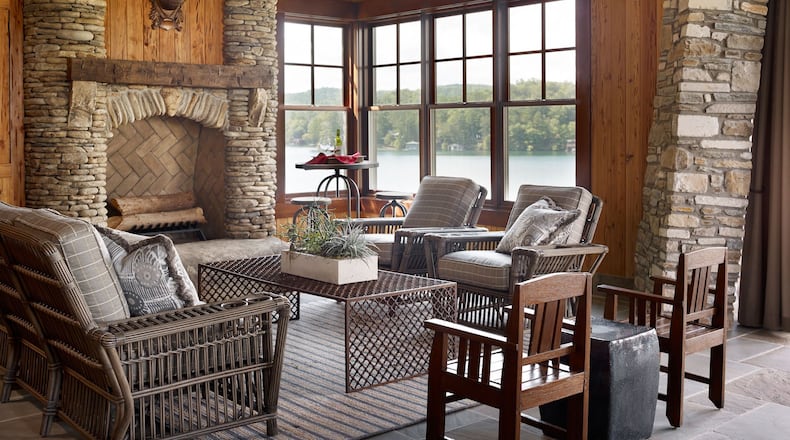Human beings now spend the majority of their time indoors. And as our lives move further from nature and become more dependent on the built environment, scientists are pointing out our innate emotional and physical need for nature. A 2020 study from the European Centre for Environment and Human Health at England’s University of Exeter Medical School found that spending just two hours a week in nature led to better health and well-being.
Biophilia or “love of life” was coined in the 1964 by writer Erich Fromm and expanded by renowned Harvard naturalist Edward O. Wilson to describe the pleasure that human beings find in nature and living organisms. Former Yale social ecology professor Stephen R. Kellert, co-author of “Biophilic Design,” describes biophilia as “beneficial contact between people and nature in modern buildings and landscapes.”
Credit: Photo by Jay Simon of Ten Ten Creative
Credit: Photo by Jay Simon of Ten Ten Creative
To that end, the growing trend of biophilic design recognizes that we now spend, by most figures, 90% of our time in our homes and businesses. Biophilic design thus aims to bring the health benefits of nature inside using colors, patterns and materials found in nature and our connection with the outdoors to reduce stress and enhance mood and well-being. According to that same Exeter study, exposure to nature can bring “lower probabilities of cardiovascular disease, obesity, diabetes, asthma hospitalization, mental distress and ultimately mortality” among adults.
Interested in how to bring biophilic principles into your own space? Try these ideas in your home and work spaces.
Credit: Photo by Cary Smith/The Victorian Atlanta
Credit: Photo by Cary Smith/The Victorian Atlanta
1. Introduce plants to your home. A critical tenet of biophilic design is bringing elements of nature indoors whether that means installing a living wall, growing herbs on your window sill or using a hydroponic grower to provide fresh lettuce all year round. The health benefits of indoor houseplants are long-established. Plants help clean the air of chemicals and replace carbon dioxide with fresh oxygen. But plants offer even more benefits when it comes to our mental health — for instance, the presence of plants in the home has been shown to reduce stress.
2. Use shades found in nature. White kitchens have been dominant in American homes for some time, but that preference is now experiencing a sea change. The biophilic trend has moved into kitchens, where earthy terracottas, sage greens and intense blues are becoming a refreshing change from the norm. The National Kitchen and Bath Association (NKBA) is predicting a move away from white kitchens in 2024 into more use of wood and wooden cabinets. In fact, wood is now second in popularity, the NKBA says, to green kitchens. Using natural hues you love, whether from the desert, beach or forest, in paint colors, furniture and other aspects of your home can enhance mood.
3. Look for materials sourced from nature. Furniture, fabrics and accessories with organic sources such as wood, stone, marble, rattan, leather, glass and wicker have a new prominence in interior design. But rather than sanded and painted and changed from their natural forms, look for live edge wood pieces or wood whose knots and imperfections are foregrounded to celebrate their origins. By the same token, chunks of stone are being used in raw form as tables, and the streaks and colors of marble are being retained, as homeowners embrace design that doesn’t try to hide its natural origins.
Credit: Kelly Blackmon of Emily Followill Photography/Liz Williams Interiors
Credit: Kelly Blackmon of Emily Followill Photography/Liz Williams Interiors
4. Bring in natural light. Sunlight boosts the human body’s production of vitamin D, which supports bone and muscle health, boosts the release of the feel-good hormone serotonin, helps regulate sleep and reduces depression. All the more reason to use windows, skylights and sliding glass doorways to flood your space with light. Opting to leave off window coverings is one option if bringing in the maximum amount of light is your aim. Lighter paint color and mirrors or, in the kitchen, glazed tile and plenty of pendant lights, can create a brighter effect.
5. Mimic the shapes of nature. The complex forms of nautilus shells and the cellular patterns of leaves can be replicated in upholstery, in tile and wallpaper. Look for decor that takes its cue from nature’s structures — such as hives, honeycombs, the swells of ocean waves or the ridges formed by wind on sand dunes — which all bring the patterns of nature to your space.
6. Consider using green building materials. Homeowners are increasingly interested in using renewable building materials so that the spaces where they live and work are also rooted in nature and better health. Non-toxic, often renewable, sustainable building materials, such as bamboo, clay, straw, cork, sand, bioplastics, stone and recycled materials, are desirable because they don’t introduce chemicals and potential toxins into homes. Many of those materials — including bamboo, straw, hempcrete, mycelium and cork — are one-better because they are biodegradable. As such, they can be reintegrated into the Earth when they are no longer needed instead of littering landfills.
Credit: Terracotta Design Build/Photo by Jeff Herr
Credit: Terracotta Design Build/Photo by Jeff Herr
7. Create connections between inside and outside. If a kitchen or bedroom renovation are in your future, consider ways to add accordion or sliding glass doors, a balcony or screened porch to connect those rooms to the outdoors. Even if an overhaul isn’t in your plans, keeping fresh air flowing by leaving windows and doors open can create that pleasant, essential connection with the sounds of birdsong, water and the sensations of nature.
Felicia Feaster is a longtime lifestyle and design editor who spent 11 years covering gardening, interior design, trends and wellness for HGTV.com. Felicia is a contributor to MarthaStewart.com and has been interviewed as a design expert by The New York Times, Forbes and the Associated Press.
About the Author
The Latest
Featured




